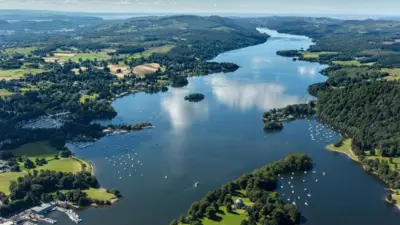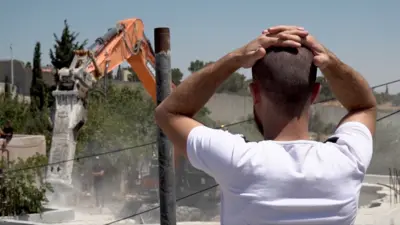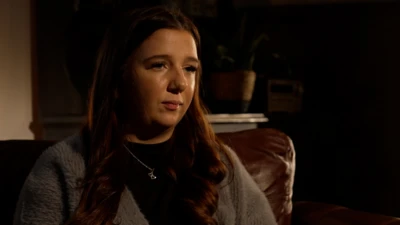We've updated our Privacy and Cookies Policy
We've made some important changes to our Privacy and Cookies Policy and we want you to know what this means for you and your data.
The island people with a climate change escape plan
- Author, Linda Pressly
- Role, ΒιΆΉΤΌΕΔ News, Panama
The low-lying Caribbean islands inhabited by Panama's indigenous Guna people are threatened by rising sea levels and increasingly unpredictable weather. But unlike many island communities facing such problems, the Guna have an escape plan.
The tiny port of Carti on the mainland of Panama is the jumping-off place for day trippers who come to swim, splash and snorkel around the idyllic-looking islands that dot the horizon. Motor boats buzz in and out carrying smiling visitors wearing life jackets and sun hats. It's one of Panama's premier tourist destinations.
The islands - almost one for every day of the year - make up the Guna Yala autonomous region, together with a strip of territory on the mainland.
Most Guna communities live on the archipelago, and have done for centuries, after they were driven offshore by disease and venomous snakes. But now many believe that only a move back to the mainland can secure their future.
It is the people of Gardi Sugdub - Crab Island - who are in the vanguard of the relocation project. A kilometre inland from the port, where the earth is the colour of rusty nails, they have set aside 17 hectares (42 acres) for the development of a new village - La Barriada. Unlike other communities around the globe threatened by the vagaries of climate change, the Guna people have a huge advantage: they already own the land they want to relocate to.
Victoria Navarro is one of those from Gardi Sugdub who pictures a new, more spacious existence on dry, higher land.
"I can imagine the community here in La Barriada," she says, looking out across the area of low, tropical vegetation that features a stream, and a small hill.
"My grandchildren want to play soccer and volleyball, but there's no place for them to do that on the island. Here they can be free like the birds."
Back in 2010, Victoria and her island neighbours began to clear this land, close to the area where they grow crops, in preparation for construction of the new village.
"Everyone came and participated," she remembers. "It was a very happy time."
Around the same time, with finance from the Inter-American Development Bank, Panama's national government began work on a huge new school adjacent to La Barriada. The $9m complex, designed for students from across the archipelago, is almost complete. A little further down the hill, $11m was invested in a new health centre.
Everything looked hopeful, especially when the government made a commitment in 2015 to build 300 houses in La Barriada - the Guna may own all this land, but they do not have the financial resources to develop so many homes.
Find out more
- Listen to Linda Pressly's report on Panama's vanishing islands for Crossing Continents at 11:00 on Thursday on ΒιΆΉΤΌΕΔ Radio 4
- Or catch up later on the ΒιΆΉΤΌΕΔ iPlayer
However, today work on the school and hospital has halted, as a result of a litany of contractual hiccups - and crucially, a failure to plan for adequate supplies of water and electricity. Work never began on the 300 houses.
The Guna are disappointed but undeterred, and they continue to lobby and to raise funds.
Victoria is an optimist. She still comes every so often to La Barriada to help re-clear those 17 hectares. Even so, this patch of land is slowly being reclaimed by the jungle - much as Victoria's home is gradually being swallowed by the Caribbean Sea.
Her island, Gardi Sugdub, is just 400m long and 150m wide, but it is occupied by about 2,000 people. Every inch of the island is built on, unless it's part of a sandy footpath. Victoria herself lives in a compound with 50 of her extended family - 17 people share her simple bamboo home.
The lack of space for a growing population once seemed to be a bigger problem than the rising sea level, which has been creeping up at a rate of between 2.3mm and 2.5mm per year - roughly an inch every 10 years. But efforts to enlarge the island may have made its inhabitants more vulnerable to the effects of climate change.
Delfino Davies, who works as a guide for visiting tourists, lives with the rest of his extended family in six simple bamboo houses constructed in a line radiating from the centre of the island out to the shoreline. It made sense to his forefathers to push the shore further away.
"My grandfather, Charlie Davies, when he came here it was a small island so he reclaimed land. He brought the stone here, and extended his land," he says.
This has happened across the Guna archipelago. People have infilled around the edges of the islands using stone, rubbish, and - most controversially - coral.
"Coral reefs stop wave action. So when you remove the coral, even down to 3m in depth, you have no protection. This has created chaos for people," says Dr Hector Guzman, a research scientist at the Smithsonian Tropical Institute in Panama City.
"The Carti area was where we got the most dramatic data about the destruction of the coral reef when we compared aerial photos taken in the 1960s and then again in 2003."
This means that the islanders are now particularly vulnerable to storm surges, and when the rain and wind come, Victoria Navarro often finds herself ankle-deep in water at home.
"I never sleep well - we're awake 24 hours a day," she says.
In 2008, severe storms tore across the island over two long weeks. Although a move to the mainland had already been mooted, it was in the wake of that destruction that people on Gardi Sugdub began to put together a plan.
The Guna are very well-organised. Sailas, spiritual and civic leaders, take decisions based on input from the community - on Gardi Sugdub there are meetings almost every day. And a committee dedicated to the relocation plan is responsible for driving it forward and liaising with government agencies.
"This project's going to be a model for the rest of the Guna people," says Blas Lopez, a sociologist and community activist. "But some of the other island communities don't think it will happen. They see the government hasn't supported us, so they're waiting to see if it will become a reality. If we achieve our dream, other communities will move back to the mainland too."
On the much smaller nearby island of Gardi Muladup, a lack of space means pigs snuffle and feed in pens constructed over the ocean. Carlos Perez, one of the sailas for this community of 500, is a sprightly 102 years old. And he is worried.
"We can't control the water," he says. "In January and February there are very strong winds, and huge waves."
This island has even less protection than Gardi Sugdub.
"We're a solitary island - there are no other islands in front of us, so we're much more vulnerable to flooding."
Carlos Perez says his people want to move back to the mainland too. They have a piece of land on the mainland they call Red Mountain, and they hope to follow the people of Gardi Sugdub.
Not everyone is looking forward to a new life on dry land, though.
Even though her home floods, Antoneta Reurter, the mother of six children, says she has no plans to leave Gardi Sugdub. In fact, she is hoping she will acquire more space for her family if her neighbours move to La Barriada.
And she does not trust predictions that some of the islands on the archipelago could be flooded in a decade.
"I don't believe the scientists," she says. "I don't think the islands will disappear - only God can decide that. If people are corrupt and behave badly, God can send a hurricane or an earthquake and maybe then the islands could go."
Her view - that other-worldly powers may punish the Guna for wickedness - is not one shared by the director of education on Gardi Sugdub, Francisco Gonzales.
"We're more and more affected by climate change," he says. "And what we're seeing lately isn't the same as what we've seen before - the weather can be really good, then there's a sudden change. The sea's rising, there are floods in the streets and high winds damage the school's roof. When that happens we have to send the children home to keep them safe."
Five hundred students squash into the island's classrooms in shifts. The new school next to the illusory La Barriada on the mainland should have opened three years ago. When - yet again - classes failed to commence this year, the people protested, blocking the main road leading inland from the port of Carti, and demanding an end to false promises.
Now it seems the government of President Juan Carlos Varela may be listening.
"We hope we can re-start work on the school, and complete it in the first quarter of 2018," Jorge Gonzalez, the minister who has taken the lead on the relocation project, told the ΒιΆΉΤΌΕΔ.
"We're going to try and find the economic resources, and get electricity to the school and the health centre."
And what about La Barriada, and the construction of those 300 homes he promised back in 2015?
"They're in the budget for this year and next - the Ministry of Housing's in the process of contracting a company than can build them. We're hoping they will be delivered in 2018.
That's a reality."
And there are signs the government's commitment is genuine - housing officials have since visited La Barriada to inspect the land. So perhaps, after all, the Guna's foresight will pay off, and their efforts will provide a model for other communities confronting climate displacement in the region and beyond.
Photographs taken by Simon Maybin
Join the conversation - find us on , , and .
Top Stories
More to explore
Most read
Content is not available








